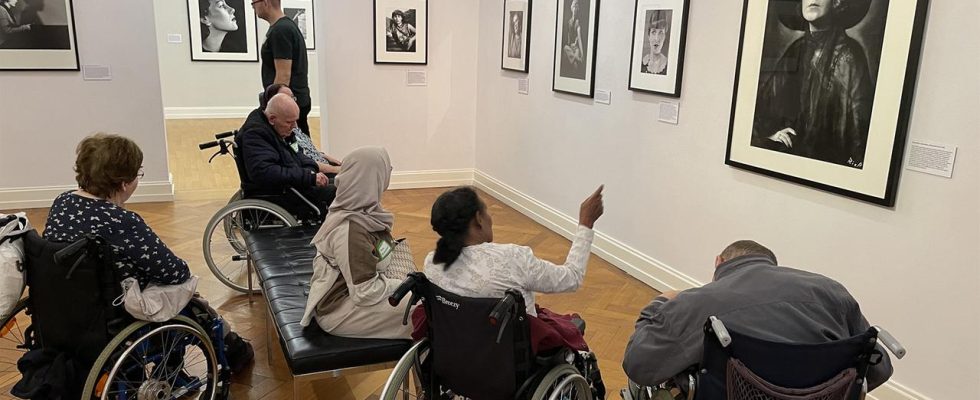In the middle
In the Opel villas in Rüsselheim, people with dementia can experience art. The special museum tours awaken memories and stimulate the senses.
It’s often the small reactions: a smile or tapping your feet, sometimes even singing. From time to time even a contribution to the discussion. When museum director Beate Kemfert mentions Berlin during her tour of the museum, one visitor pricks his ears. He was born there, long before the division, he calls out to her. The man is well over 80 years old and has dementia.
The tour is about pictures by the photographers Frieda Riess and Yva, who produced their works in the 1920s. The art activates the elderly visitor who lives in the Hufeland-Haus, a nursing home for the elderly in Frankfurt am Main. It awakens memories in him that may have slumbered in secret for a long time.
Strong demand
“It’s always a really nice moment,” explains museum director Kemfert. “If the visitors can open up and participate, then that’s just great to experience.” After personal experiences in his own family, Kemfert developed the idea of offering guided tours for people with dementia. In May 2013, the first group of dementia patients visited the Opelvillen. Since then, the tours have taken place regularly. The demand for this offer is constantly growing.
The museum staff takes care of the visitors for one and a half to two hours during the guided tours. Art educators explain the connections. The senses should be stimulated with props such as hats, feathers or the use of music. A reference should be made to the artworks shown. As a reminder, Polaroid photos are snapped, which the visitors can take with them to their dormitories.
Capture the moment: Polaroid photos as a reminder of the museum tour
Activate reminders
Almost everyone then wants to put on the big hat that the employees brought with them. Some visitors also put on the pearl necklace or the feather boa. The 1920s are not only present in the photos hanging on the walls. They are also brought to life with the help of the props. And with them the demented visitors. A look in the mirror makes a lot of people laugh.
“We do some activities in the dormitory,” explains social worker Udita Ahmed. “But the way they thrive here, outside of their usual environment, that’s something special,” says the supervisor, turning around and looking straight into a face beaming with joy.
The introduction to the theme of the exhibition begins at the coffee table.
interaction and music
Before the tour of the building begins, the groups of visitors can get used to their new surroundings over coffee and biscuits. The guided tours for people with dementia only take place on the days when the exhibition center is closed. So that the employees can fully devote themselves to the disabled visitors and they are not disturbed.
Of course, the introduction to the topic begins at the coffee table. The conversation prepares the visitors for the tour. Meanwhile, an LP is spinning on the turntable. “The little green cactus” echoes through the room. Some people hum along quietly.
No substitute for therapy
At the end there is well-deserved applause for the museum staff. All around you see happy faces. The approach of giving people with dementia a little break that makes them happy has been successful. The museum and supervisors agree on that. A man in a wheelchair calls out that he really wants to be part of the next tour. It’s an experience he won’t forget.
Even if the guided tours in the Opel villas have no therapeutic approach and cannot replace therapy: “The aim is to create a quality of life for people,” explains museum director Kemfert. “Quality of life that can beautify the moment.”

